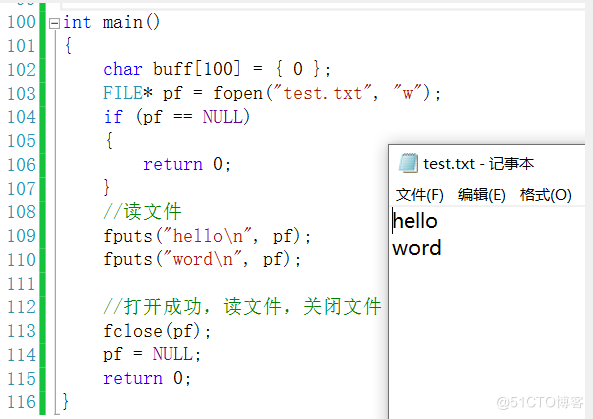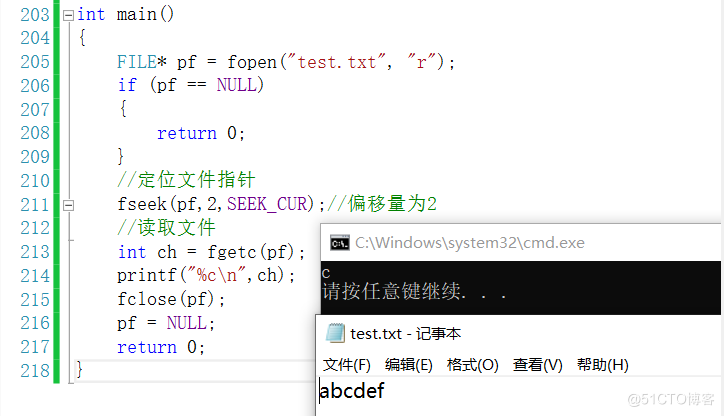C语言文件操作
不知名小赖 人气:0前言
接上一篇 C语言文件操作详情(一)
一、文件的顺序读写函数
fgetc和fputc
- fgetc
字符输入函数 适用于所有输入流 - fputc
字符输出函数 适用于所有输出流
int fgetc( FILE *stream ); int fputc( int c, FILE *stream );
- fputc 写文件
int main()
{
FILE* pfWrite = fopen("test.txt", "w");
if (pfWrite == NULL)//检验
{
printf("%s\n", strerror(errno));//如果写文件错误打印错误原因
return 0;
}
//写文件
fputc("a", pfWrite);
fputc("b", pfWrite);
fputc("c", pfWrite);
//关闭文件
fclose(pfWrite);
pfWrite == NULL;
return 0;
}
- fgetc 读文件
int main()
{
FILE* pfRead = fopen("test.txt", "r");
if (pfRead == NULL)
{
printf("%s\n", strerror(errno));
return 0;
}
//读文件
printf("%s", fgetc(pfRead));//a
printf("%s", fgetc(pfRead));//b
printf("%s", fgetc(pfRead));//c
//关闭文件
fclose(pfRead);
pfRead == NULL;
return 0;
}
fgets和fputs
- fges 文本行输入函数 适用于所有输入流
- fputs 文本行输入函数 适用于所有输出流
两个函数的功能:
//Get a string from a stream. 从流中获取字符串。 char *fgets(char *string, int n, FILE *stream); //Write a string to a stream. 将字符串写入流。 int fputs(const char *string, FILE *stream);
用fgets函数读取一行:
int main()
{
char buff[100] = { 0 };
FILE* pf = fopen("test.txt", "r");
if (pf == NULL)
{
return 0;
}
//读文件
fgets(buff, 100, pf);
printf("%s", buff); //注意buff里面本身就有一个换行符 (文件里面末尾有换行符)
//打开成功,读文件,关闭文件
fclose(pf);
pf == NULL;
return 0;
}
读取一行打印到显示器上 如图:

用fputs函数写一行:
int main()
{
char buff[100] = { 0 };
FILE* pf = fopen("test.txt", "w");
if (pf == NULL)
{
return 0;
}
//写文件
fputs("hello\n", pf);
fputs("word\n", pf);
//打开成功,写文件,关闭文件
fclose(pf);
pf = NULL;
return 0;
}
用fputs 写一行到文件里面:如下:

fgets和fputs也可以操作键盘和屏

键盘输入abcd 回车 屏幕打印 abcd
fscanf 和 fprintf
- fscanf 格式化输入函数 适用于所有输入流
- fprintf 格式化输出函数 适用于所有输出流
简单对比 scanf 和 fscanf,printf 和 fprintf,用法都非常相似
int scanf( const char *format [,argument]... ); int fscanf( FILE *stream, const char *format [, argument ]... ); int printf( const char *format [, argument]... ); int fprintf( FILE *stream, const char *format [, argument ]...);
fprintf 写文件
struct S
{
int n;
float score;
char arr[10];
};
int main()
{
struct S s = { 100, 3.14, "abc" };
FILE* pf = fopen("test.txt", "w");
if (pf == NULL)
{
return 0;
}
//格式化的形式写文件
fprintf(pf, "%d %f %s", s.n, s.score, s.arr);
fclose(pf);
pf = NULL;
return 0;
}

fscanf 读文件
struct S
{
int n;
float score;
char arr[10];
};
int main()
{
struct S s = { 100, 3.14, "abc" };
FILE* pf = fopen("test.txt", "w");
if (pf == NULL)
{
return 0;
}
//格式化的形式输入数据
fscanf(pf, "%d %f %s", s.n, s.score, s.arr);
fclose(pf);
pf = NULL;
return 0;
}
当然fscanf和fprintf函数同样可以运用于标准的输入输出流(stdin,stdout)
对比一组函数
- scanf/fscanf/sscanf
- ptintf/fprintf/sprintf
scanf/printf:是针对标准输入流/标准输出流的 格式化输入/输出语句
fscnaf/fprintf:是针对所有输入流/所有输出流的 格式化输入/输出语句
sscanf/sprintf:sscanf是从字符串中读取格式化的数据。sprintf是把格式化数据输出成(存储到)字符串
fraed 和 fwriite
- fread 二进制输入函数 适用于 文件
- fwrite 二进制输出函数 适用于 文件
size_t fwrite( const void *buffer, size_t size, size_t count, FILE *stream );
size_t fread( void *buffer, size_t size, size_t count, FILE *stream );
struct S{
char name[20];
int age;
double score;
};
int main()
{
struct S s = { "张三", 20, 55.6 };
FILE* pf = fopen("test.txt", "wb");
if (pf == NULL)
{
return 0;
}
//二进制形式写文件
fwrite(&s, sizeof(struct S), 1, pf);
fclose(pf);
pf = NULL;
return 0;
}
fread 读文件 ,fwrite 写文件 。两个函数用法类似
二、文件的随机读写函数
前面介绍的函数都是顺序读写函数 ,有时候我们需要从某一个位置开始读写函数。下面的这些函数可以实现其功能。
fseek 函数
根据文件指针的位置和偏移量来定位文件指针
Moves the file pointer to a specified location.
int fseek( FILE *stream, long offset, int origin );
//三个参数所指的内容:pf 偏移量 文件指针的当前位置
int main()
{
FILE* pf = fopen("test.txt", "r");
if (pf == NULL)
{
return 0;
}
//定位文件指针
fseek(pf,2,SEEK_CUR);//偏移量为2
//读取文件
int ch = fgetc(pf);
prinf("%c\n",ch);
fclose(pf);
pf = NULL;
return 0;
}

如图从文件指针的当前位置 a 前面开始偏移量为2,打印c
- SEEK_CUR
Current position of file pointer (文件指针的当前位置) - SEEK_END (文件的末尾位置)
End of file - SEEK_SET (文件起始位置)
Beginning of file
三、关于文件结束的判定
我们知道:EOF --> end of file 文件结束的标志
如果一个文件里面什么都没有我们打开文件读到的就是 “-1”,文件结束的位置有一个EOF存在。
feof函数
- 牢记:在文件读取过程中,不能用feof函数的返回值直接来判定文件的是否结束。
而是应用于当文件读取结束的时候,判断是读取失败结束,还是遇到文件尾EOF使文件结束。
- 文本文件是否读取结束,判断返回值是否为EOF或则NULL
例如:fgetc判断是否为EOF fgets判断返回值是否为NULL - 二进制文件的读取结束判断,判断返回值是否小于实际要读的个数
例如:fread 判断返回值是否小于实际要读的个数
总结
加载全部内容